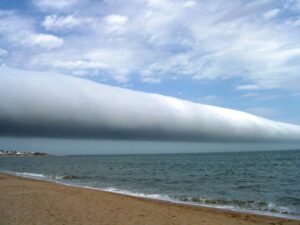GS1 – Geography

Context
During an ongoing heatwave, Portugal experienced a spectacular and rare roll cloud, a dramatic atmospheric event.
What Are Roll Clouds?
Roll clouds, also termed volutus, belong to the arcus cloud family. They are rare, tube-shaped horizontal clouds that appear to roll along their horizontal axis.
- Visual Appearance: Unlike storm clouds, roll clouds resemble giant cylinders or even tsunami waves across the sky but are not associated with seismic or oceanic activity.
Formation Process:
- Triggered by intense surface heating, which causes warm, dry air to ascend rapidly.
- The rising warm air collides with cooler sea breezes, leading to turbulence and condensation that produces the roll shape.
Risks and Significance:
- The cloud itself is harmless but can be accompanied by sudden, strong gusts, posing a hazard to those unaware.
- Climate experts warn of the potential rise in frequency and intensity of such phenomena due to global warming and intensifying heatwaves.
Arcus Clouds – Classification:
- Arcus clouds form along the boundaries of thunderstorms or cold fronts, marking the interface between warm and cool air masses.
- Two Types:
- Shelf Clouds: Attached to the base of a storm cloud, resembling a shelf or wedge. Indicate incoming storms, rain, and winds.
- Roll Clouds: Not connected to storm bases and can appear without thunderstorms.




